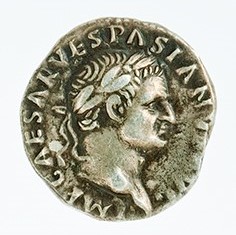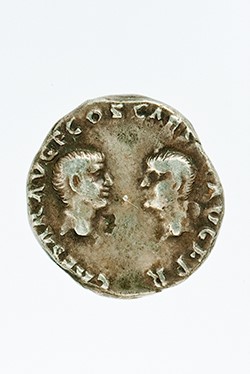Title: Denarius of Vespasian - 1971.09
Acquisition number: 1971.09
Author or editor: Beryl Rawson
Culture or period: Roman Imperial
Date: AD 70
Material: Metal - Silver
Object type: Coins - Roman
Dimensions: 16mm (w)
Origin region or location: Italy
Origin city: Rome
Display case or on loan: 7
Keywords: Coin, denarius, Roman, Imperial, Vespasian, Titus, Domitian
Mattingly, H., E.A. Sydenham, C.H. Sutherland, R.A. Carson, The Roman Imperial Coinage 13 vols (London, Spink, 1923-1994) 16; Mattingly, H.,Coins of the Roman Empire in the British Museum, 6 vols (London, 1965) 2-5; Seaby, H.A., Roman Silver Coins (London, B.A. Seaby, 1967) 25.
1971.09
Denarius of Vespasian
3.366 g. AD 70
Obv.: Head of Vespasian r., laureate. IMP(erator) CAESAR VESPASIAN[VS A]VG(ustus)].
Rev.: Heads of Titus and Domitian facing each other. CAESAR AVG(usti) F(ilius) CO(n)S(ul) CAES[AR] AVG(usti) F(ilius) PR(aetor).
This coin shows the importance which Vespasian attached to the succession, from the beginning of his reign. His elder son Titus already held supreme military power in the Jewish War, and the award of a consulship to him for AD 70 was a preparation for his return to civil responsibilities in Rome (AD 71). The other son Domitian was twelve years younger than Titus, but received a praetorship in AD 70, while his father and brother were still absent from Rome. Titus and Domitian appear together on several varieties of Vespasian’s coinage at this time (in gold, silver and bronze), but all of the types are comparatively rare.
The obverse titles indicate the first year of Vespasian’s reign. In November AD 70 he added the title ‘Pontifex Maximus’.
Mattingly, H., E.A. Sydenham, C.H. Sutherland, R.A. Carson, The Roman Imperial Coinage 13 vols (London, Spink, 1923-1994) 16; Mattingly, H.,Coins of the Roman Empire in the British Museum, 6 vols (London, 1965) 2-5; Seaby, H.A., Roman Silver Coins (London, B.A. Seaby, 1967) 25.

